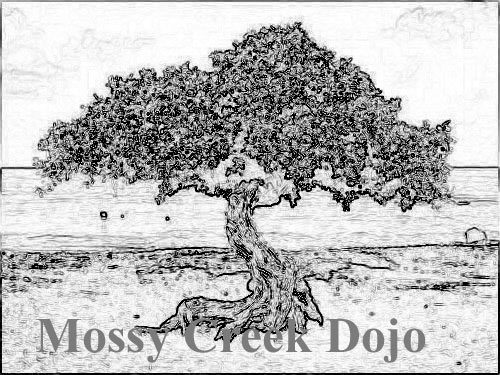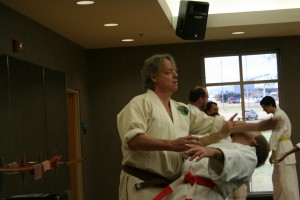What is Aikido?
Aikido is a responsive martial art in which the practitioner uses off-balances and an attacker’s own strength and momentum to gain control instead of attempting specific techniques to prevail. An advantage of this tactic is that Aikido can be performed by people of almost any age or size, often despite physical limitation, and still be effective against even the largest and strongest of individuals.
Because of the risk of physical harm inherent in the practice of any martial art, Aikido practice is co-operative in nature. We do not train with “opponents,” but with “partners.” When we practice a technique, our partner’s job is to set up a situation in which that particular technique will work properly. The partner, or uke, does this by attacking and reacting in a specific way which safely simulates a real attack. At advanced stages of practice the partner may begin trying to counter the technique if given the opportunity; this type of practice leads to free form practice called randori.
Aikido has no unified religious aspect. Instead there is a philosophy which is more or less shared by most Aikidoka. The core of this philosophy includes two fundamental threads: a commitment to peaceful, creative resolution of conflict whenever possible and a commitment to general self-improvement.
Brief History of Aikido
Aikido was invented in Japan during the early 20th century by a man named Morehei Uyeshiba. Uyeshiba had previously intensely studied various forms of armed and unarmed fighting such as jujitsu, stick-fighting, and spear-fighting. All of these previous studies blended with Uyeshiba’s own ideas into what became known as Aikido.
Morehei Uyeshiba taught for many years in various parts of Japan. During this time he taught the men who were to spread Aikido throughout the world. Many of Uyeshiba’s prominent students studied with him after World War II and continue with Hombu style aikido, namely Saito, Chiba, Saotome, and Tohei. Founders of their own schools of Aikido are Gozo Shioda and Kenji Tomiki, who were among Uyeshiba’s first students prior to WWII. Kenji Tomiki was a high ranking judoka when he began studying under Uyeshiba. While different students each picked up on different aspects of Uyeshiba’s teachings, Tomiki believed the literally thousands of techniques were essentially variations on some recurring central techniques that could be taught easier and more in-depth.
When Tomiki began teaching Aikido classes at Waseda University and at the Kodokan, he interpreted and conveyed the aspects of Aikido in terms of his Judo training, namely: a strong emphasis on off-balance and ways to proliferate Aikido in modern society. He also included some elementary principles essential to proper execution of techniques.
Tomiki trained many notable individuals during his lifetime, including Hideo Ohba, Takeshi Inoue, Tsunako Miyake, Riki Kogure, and Karl Geis. With Kogure’s help and Miyake’s support, Geis and his students intensely studied Aikido with an eye for utility and practicality over aesthetics, thereby furthering the development of Aikido into the viable self-defense we study today. Chuck Caldwell and Nick Lowry are two of Geis’s senior students that we study with today. This search for knowledge continues.

